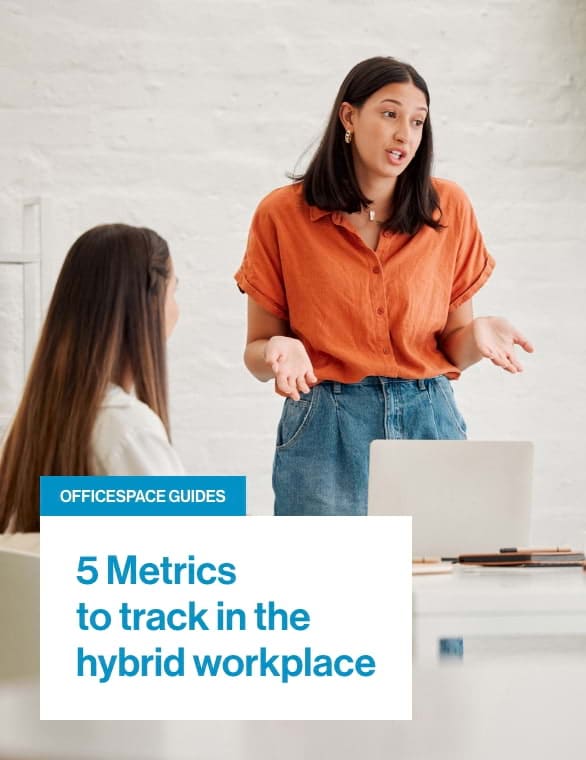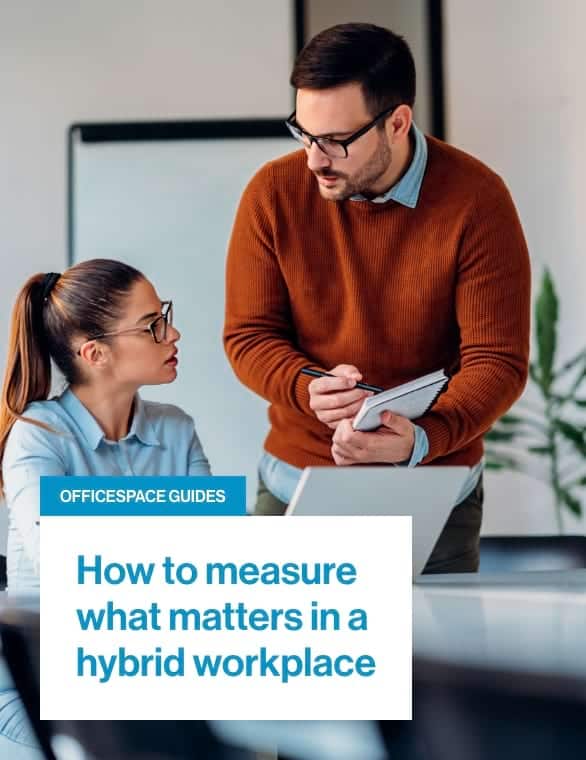2023 Workplace Strategy Report
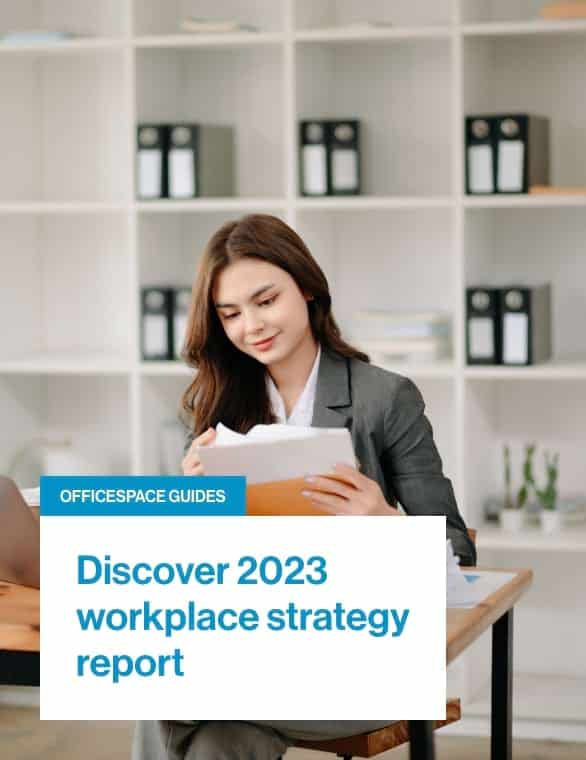
Discover how today’s hybrid workplace leaders are finding better ways to meet business goals and improve employee experience, by asking—and answering—the right questions with the right data.
EXECUTIVE SUMMARY
Why Your Workplace Strategy Needs a Change
As companies develop an effective workplace strategy that accommodates both the realities of hybrid working and their unique business objectives, they’re bumping up against the same questions:
How can we make accurate, data-driven decisions for our workplace? How can we optimize our corporate real estate without sacrificing employee experience? What does change management actually mean when seemingly everything is changing?
OfficeSpace surveyed over 150 workplace leaders and analyzed thousands of data points across our 1000+ client base to see how leadership is making strategic choices to improve their workplaces without sacrificing the bottom line.
The current workplace is in flux, challenging strategists to accommodate increasingly dynamic use of space. While there’s no one-size-fits-all answer when it comes to workplace strategy, some best practices and technologies are emerging to help optimize—and continuously improve—workspaces for every stakeholder.
HYBRID WORK STILL COMPLICATES BUSINESS STRATEGIES
Strike the right balance between office and remote work

As employees started coming back to the office in larger numbers, companies quickly discovered that flexible working is easier said than done. Our survey analysis and platform data shows that despite widespread adoption, getting hybrid work models right isn’t a simple process—in large part because companies are still struggling to find the right balance between on site and remote work.
Given how much employees value flexibility, it’s not surprising that leaders are almost evenly split on whether or not to mandate office attendance.
Report key insights:
- How many people are currently working in the office?
- What days of the week are currently most popular?
- What in-office attendance are companies expecting in 2023?
- And more
WORKPLACE DESIGN CAN FOSTER CONNECTIONS
Create a work environment with purpose
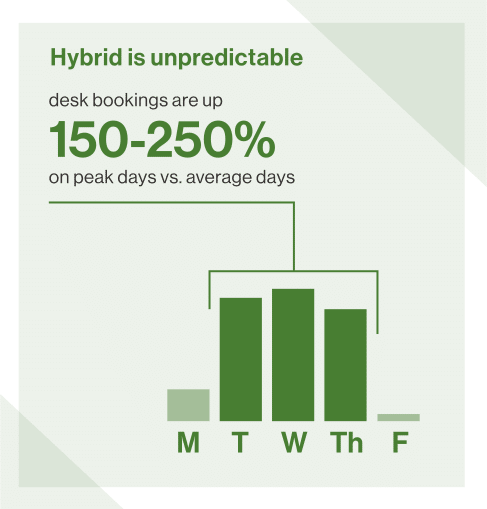
As companies develop a business strategy for hybrid work, they face another challenge: creating an office that’s better suited for collaboration and culture. What initiatives will help realign the office’s role to make it more conducive to in-person activities? How can office space itself improve hybrid approaches while simultaneously reflecting (and enhancing) company culture?
Given the fluctuating nature of office use today, decision makers are concerned with how to adequately right-size, refit, and redesign their offices to meet employee demands and usage. Any changes to better foster collaboration, socialization, or private work should be intentional, to help support new behaviors.
Report key insights:
- How can the size and purpose of the office better meet employee needs?
- How can workplace design help to maintain or enhance productivity?
- How can you address company goals around culture and collaboration in the hybrid workplace?
- And more
DATA-DRIVEN AGILITY IS KEY
Test, measure, learn, and adapt for workplace success
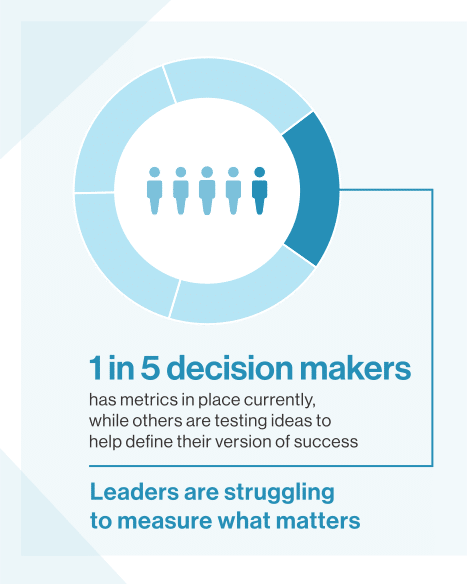
Leaders recognize the importance of leveraging utilization metrics to reduce costs and refine the in-office experience. But the established ways of measuring office utilization (i.e.: occupancy rate) are clumsy or irrelevant in a hybrid working scenario. To identify a clear path forward, organizations will need to take an entirely fresh approach to the workplace.
Only one in five workplace leaders currently has clear goals or targets in place for their office use. The majority are looking for direction on ways to ensure space utilization never falls behind employee needs or company goals.
Trial and error will be a constant in 2023, as companies refine and redesign their hybrid work approaches. This kind of agility requires a new way of thinking, new processes, and for some, new technology.
Report key insights:
- How will leadership know if the changes they’re making are working as planned?
- How can workplace management and office use be measured and improved?
- What datasets can workplace leaders collect and analyze to measure their success?
- And more
2023 Workplace Strategy Report
Discover insights, tactics, and strategies workplace leaders from some of the world’s top brands are leveraging to build a hybrid workplace that works for both employees and employers.
Frequently Asked Questions
Get answers to some of the most common workplace strategy questions
What is a workplace strategy?
A workplace strategy is an organization’s plan for aligning their physical spaces and IT/facilities management infrastructure with their company culture, preferred ways of working, and overarching business goals. A good workplace strategy is one that uses data from multiple sources. This is in order to create a better understanding of current space utilization and to anticipate future space needs. Ultimately, the goal is typically to lower costs while still keeping employees engaged, productive, and happy.
What is the purpose of a workplace strategy?
The purpose of a workplace strategy is to ensure physical spaces actually support long-term business goals. Of course, this is while also fostering collaboration, company culture, and employee engagement. A good, data-driven workplace strategy can help employees remain efficient and productive. And it can also lead to a more cost effective use of space over time.
How do you develop a workplace strategy?
To develop a new workplace strategy, companies need to understand the ways their employees currently work, by collecting and analyzing real-time data so they can ask (and answer) complex questions about their current space use (i.e.: How are varying hybrid schedules impacting productivity and collaboration? When and why do our employees use the physical office? And what metrics can we track to better understand employee presence?).
From there, they can define their goal(s) for the workplace, and begin implementing and tracking any changes.
Thanks to the rise in hybrid working, companies now need to develop a workplace strategy that strikes the right balance between in-office work and remote work.
To do this, leadership should be willing to experiment with different office configurations (hoteling? hot desking? activity-based working?), learn from the results, and adjust accordingly. Ideally, the employees themselves will be included in this process, which can help ensure buy-in.
What are the benefits of workplace strategy?
Data-driven workplace strategies can help create physical spaces that are both efficient and engaging. A customized, carefully planned strategy can also enhance company culture and employee satisfaction, boost collaboration, and support talent retention and attraction efforts.
Other benefits of the right workplace strategy include real estate cost savings, easier flexible and/or hybrid work implementation, happier employees with a better work-life balance, improved performance and productivity, and improved sustainability.
In short, a good workplace strategy can future-proof the office by helping decision makers to make real estate investments (or divestitures) and/or workplace transformations that are more likely to enhance productivity and efficiency, without sacrificing the bottom line.
What are the three strategies in the organization of the workplace?
Strategists and workplace consultants tend to focus on three levels of organization in the workplace. Ranging from the broadest to the most specific, these are (1) top-level/corporate strategies, (2) department-level/business strategies, and (3) employee-level/tactical strategies.
In the physical workplace, these three strategies translate to (1) real estate decisions that impact entire (and sometimes multiple) facilities, (2) workplace design decisions that impact floor plans for different departments, and (3) activity-based working and other flexible working configurations and resources that impact the day-to-day lives and productivity of employees.
Every level of workplace strategy is best optimized using robust, real-time data collected from workplace technologies.
How do you balance efficiency and effectiveness?
An efficient workplace is one that keeps costs in check, never spending more resources than necessary. Meanwhile, an effective workplace is one that ensures employees have the tools, technology, and resources they need to meet business objectives.
To balance efficiency and effectiveness in a hybrid and/or flexible working environment, decision makers and space planners need to determine their priorities. Of course, this is along with what benchmarks they can use to track them. From there, they should collect and analyze real-time data to determine if they’re striking their desired balance. Note, this will likely be an experimental process, as companies test and iterate to see what works best for their unique needs and objectives over time.

Keep learning
Discover The 5 Metrics To Measure In A Hybrid Workplace
5 Metrics to track in the hybrid workplace Hybrid work has drastically changed how we.
How To Measure What Matters In A Hybrid Workplace
Prep for 2024 with this practical guide built for leaders who want to adapt their.
Desk Booking: What Is It And What Are The Benefits?
Desk booking has a huge role to play in the modern office. Learn about the.

